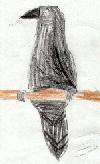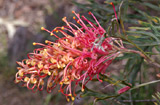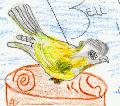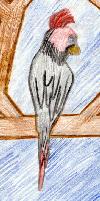|
[Front Page] [Features] [Departments] [SGAP Home Page] [Subscribe]

Attracting Native Birds into Your Garden
Frank Stephens
The bird illustrations in this article are by the students of the Emerald Primary School. More work by the students can be found at the Birds around Emerald web site.
Naturally, if you have a garden you will have birds in it. If you have native plants you stand a better chance of getting native birds into that garden, but of course if you plant an Eremophila, commonly called emu bush, you cannot expect to have emus flying in immediately! However, by persevering you will be surprised at just how much bird population will go through your garden eventually. You don't always see them but they do go through just the same.
I class birds into fairly rough groupings: the stationary or permanent birds that are either in your garden or not; the migrants such as those that come right across from Siberia down to Australia, these are the true migrants; the lesser migrants that go to the north of Australia and New Guinea and come back in the summertime; and those that we can call altitudinal migrants or birds that nest in the cooler gullies and in the winter period move around quite a bit.
The best period for getting the birds going through your garden is after and before the breeding periods when the birds are moving around and in some instances, looking for mates or nesting pots. That is why February, March and April or August-September in southern Australia are the months you will probably see the birds moving through, sometimes for only a few minutes, maybe for hours or days, but they will be there and if you have the right plantings, the right garden, they might even stay.
To get the birds into the garden the first essentials are food and water. Birds must drink and bathe just like humans. The third essential is a roof over their heads, in other words quite a bit of cover. In my backyard I have succeeded so well that when the birds get in it, I cannot see them, nevertheless they must have shelter. They also need a comfortable seat on which to rest, so dead branches, dead trees or high branches sticking up are a wonderful asset.
  | Birds you are likely to find resting in your garden are ones like the Black-shouldered Kite which is moving more and more into the city and the Black-faced Cuckoo-shrike. The Little Raven came into Melbourne in the drought of 1968 and has been quite a prominent bird here since.
Little Raven
Select the thumbnail image or bird name for a higher resolution image (20k).
|
Honeyeaters
The Silvereye is undoubtedly our most successful bird. As a honeyeater it has a brush tongue which enables it to get to the nectar in the flowers, and that same brush tongue and sharp bill help it to deal very effectively with the insects. In the autumn it gets into your soft fruits! It diversifies its feeding so easily, it is a most successful bird. In 1852, a small flock was taken to New Zealand and it is now the most common bird there.
Not all birds are honey-eaters, but most insects are and birds feed on insects. So the honey flora has a dual purpose and the best of the eucalypts is Eucalyptus leucoxylon "rosea" with its long winter flowering period. Birds need to eat every day and I am continually stressing the importance of plants that flower over a long period. Eucalyptus caesia is also very successful as a honey flora as are the mallees. Bird observers like the mallees because they do not grow terribly high, flower quite well and the birds coming into the garden can be easily seen, much easier than in a tall tree. There are birds that prefer the early eucalypts to anything else and the first of these is the White-plumed Honeyeater or Greenie, a common bird that will get into anything but prefers the eucalypts. The Red Wattlebird, that noisy, raucous villain, also prefers the gums.
 |
The colourful flowers of Eucalyptus caesia do not just appeal to humans!!
Select the thumbnail image or plant name for a higher resolution image (33k).
|
Lorikeets come much more into Melbourne than people realise. In years when the ironbarks flower poorly there can be a big influx into the metropolitan area of the Musk Lorikeet with red over the bill and behind the eyes, and the little Purple-crowned Lorikeet. The Rainbow Lorikeet was considered once upon a time a bird of Sydney and northern areas. They were known at Mallacoota (north-east Victoria) and in the western district, but they are now well established in Victorian gardens and if you have the right plants, you may be lucky. The Scaly-breasted Lorikeet has no right to be in Melbourne. A few years ago it was never recorded in Victoria. There is quite a good colony of them in the Frankston-Mt.Eliza area.
The Swift Parrot is an interesting bird. It lives in Tasmania, migrates across Bass Strait in September, comes back in March-April and disperses right up into southern Oueensland. But it has to spend its nights somewhere and for the first month that it is back, it is around the suburbs quite a bit. It is also a brush-tongued parrot.
I love banksias and some swear that Banksia spinulosa is the most effective banksia to bring in the honeyeaters. I disagree, I have B.spinulosa growing side by side with B.ericifolia in my garden, and while B.spinulosa flowers April-May, B.ericifolia starts a month earlier and flowers three or four months more. The coastal Banksia integrifolia is particularly loved by the Little Wattle-birds and B.aemula is always effective.
 |
The flowers of Banksia spinulosa are favourites of honey-eating birds and marsupials. The species has a wide natural range in eastern Australia.
Select the thumbnail image or plant name for a higher resolution image (37k).
|
The Little Wattlebird is known as the Brush Wattlebird and prefers banksias and grevilleas. The Spinebills come into our garden only in the winter time, but maybe one day they will like the look of our place and will stay there. They love grevilleas and when they are in our Grevillea asparagoides outside our kitchen window, I don't mind washing up. Also growing there is G.chrysophaea and the Little Wattlebirds and Spinebills are always at this too. Curiously, I do not find the birds in the garden going much to G.alpina like they do in the bush.
Without a doubt though, Grevillea "Robyn Gordon" is the best grevillea both for the garden, where it will grow in sand, heavy soil or clay, and the birds who simply love it. The toothbrush grevilleas are all good. Some purists may not like the hybrid "Poorinda" and "Clearview" hybrids, etc. but the birds love them. They flower practically the whole year and the birds spend more time at home in the hybrids than the pure species.
 |
Grevillea "Superb" is very similar to Grevillea "Robyn Gordon" and just as popular with the birds. Both are long flowering, medium shrubs.
Select the thumbnail image or plant name for a higher resolution image (29k).
|
The Yellow-winged or New Holland Honeyeater is disappearing a little bit from the close environs of Melbourne, but if you have any natural timber or creeks nearby, you will probably get your Yellow-winged in the garden. The Yellow-faced Honeyeater is a nomad and moves around quite a bit, but there is no reason it should not be in your garden. The White-eared Honeyeater is just as much at home in the Mallee as in the suburbs. The White-naped Honeyeater is another you can see.
The birds love Kangaroo Paws...the wattlebirds will flatten the flowers but we do not complain. Anigozanthos rufus is very good but best of all is A.flavidus in its varying forms.
Most hakeas are excellent for honey and insects and so is Dryandra formosa although callistemons are not so good for birds. Epacris longiflora, if grown in damp conditions, flowers for a long time, otherwise I find the flowers just open and close. Epacris impressa is also good. Correas in the bush have honeyeaters in them all the time, but in the gardens they are not so successful as bird feeders, except Correa lawrenciana, which is excellent. The birds love eremophilas and they also provide excellent cover for the insect eaters.
Among the melaleucas, Melaleuca hypericifolia is good because it flowers over a long period. The shrubs that flower profusely only for a fortnight or so in spring are not much use to the birds because the birds, when they have young, are more interested in stuffing their youngsters with insects with a little honey added, consequently you do not get the bird reward from these plants that you should.
Artificial Feed....Good or Bad?
  | Should you feed the birds or not? This is a vexed question and having seen kangaroos and possums coming around scrounging for handouts in National Parks and and seeing a lot of butcher birds, magpies, kookaburras and particularly the pied currawongs, crowding around for food, I am opposed to it.
Magpie
Select the thumbnail image or bird name for a higher resolution image (4k).
|
However, it is possible to feed the right birds in the right way. Do not make the birds dependent on your feeding...I put out a certain amount each morning, after that they have to go and earn their food. About the only time we really fed birds was one winter when we started off with three Red-Wattlebirds and finished up with about twenty-five and the poor spinebills were hounded and chased away. We feed them now with native plantings and natural food in the garden.
Insect Eaters
Apart from supplying honey flora, eucalypts also provide bark for insect feed. A lot of birds rely on the litter around the base of the trees for a source of food. The Yellow Robin is such a bird. When we came out to Box Hill thirty odd years ago, they were permanent residents but civilization came and the robin went. Now that we have the garden nearly as we like it, we see them occasionally, but not for long. The Scarlet Robin is usually around in March-April or August-September. The female has pink on her chest, but not as much here in Victoria as in Tasmania.
The Eastern Shrike-tit is a delightful bird and is to be seen around pulling the bark off the trees and getting to the insects. The Rufous Whistler comes down in the summertime and as it has to go from north to south, must rest in gardens. The Golden Whistler is a bird that nests in the deeper gullies but in the autumn-winter comes out into the open areas and into quite a few suburban gardens. A bird somewhat similar but not seen around so much these days is the Grey Thrush.
Spotted Pardalotes are little mites that spend their lives in the top of the trees feeding on lerps, but come down to hollows in the ground to nest. They are around all the time although you rarely see them. The Grey Fantails spent two or three days in our garden every year, but now the growth is thicker they stay a bit longer before moving out to their usual nesting areas. If you make the garden conditions right, they will be around and stay for a while. The Rufous Fantail is a migrant from Queensland and New Guinea which arrives here in October, nests, has a family and moves out about February.
The Bell Miner (Bellbird) eats a certain amount of honey but spends most of its time feeding on scale on the top of the eucalypts. They are often associated with dead trees and because they cannot control and cope with the disease and scale, often they are blamed for killing the trees, but in fact it is the scale and disease that have caused it. Bird observers say they are voracious fighters and frighten other birds away.
  | The Helmeted Honeyeater at Yellingbo is losing the fight against the bellbirds for territory. A related bird, the Noisy Miner or Soldier Bird is around the suburbs all the time.
Bell Miner
Select the thumbnail image or bird name for a higher resolution image (39k).
|
The Olive-backed Oriole is fairly rare, but around all the same, a lovely early migrant that comes down in August, leaves about February-March. If you are lucky you can put it on your home list too.
Thirty years ago, the White-browed Scrub-wren with the Yellow Robin was a constant visitor to our garden and since I have achieved a wilderness down the back, for the past five or six years, a pair of scrub-wrens have been present again. This proves to me that get your garden right and the birds will come.
  | The Blue Wren is difficult to keep these days because unfortunately there are cats that win the battle all the time.
Blue Wren
Select the thumbnail image or bird name for a higher resolution image (10k).
|
The Brown Thornbill loves to potter around in the lower and higher stuff all the time, incessantly chasing insects and are in our garden all the time.
Seed and Fruit Eaters
The main virtue in the acacias, is the insects they attract, although the Golden Wattle exudes from its stem in August-September, a form of sweet gum of which the honeyeaters in particular, are very fond. The virtue of the Prickly Moses, Acacia verticillata, is in the protection it gives to smaller birds and the insects it provides. A.prominens has lovely seeds which are very attractive to the pigeons, the two forms of Bronze-wings, the Common and the Brush Bronzewing, which unfortunately are victims of cats and getting rarer.
  | Theoretically the gumnuts attract the cockatoos and the Gang-gangs but the bird that is coming more and more into the city is the Galah. The Eastern Rosellas love the almonds in the garden.
Gang-gang Cockatoo
Select the thumbnail image or bird name for a higher resolution image (24k).
|
If you are fortunate to live near a golf links, or any space with a few trees, you then get other birds such as the Willy Wagtail, magpies and the Magpie-Lark. The kookaburras are not quite so common but still about. You will see the Welcome Swallow, a beautiful bird, and the Flame Robin, a longitudinal migrant who nests up in the high plains, 1200 metres or more, and comes down to the golf links.
There is mistletoe in all parts of Australia, not only on eucalypts; I have seen it on silver birches, apples, plums and oaks, and they all attract the attractive red and black mistletoe bird. In June you can see them in the Melbourne Botanic Gardens.
Predators
If you have your garden and your birds, you will also get the meat-eaters, the villains of the piece. The Butcherbird is about with its sharp beak and there is nothing it likes better than nestlings. The name comes from the fact that, as the butcher hangs carcasses on hooks around the shop, so the butcherbird hangs nestlings around its neck until such time as its offspring need them.
  | The Pied Currawong also has a villainous beak and loves little birds.
Currawong (and offspring)
Select the thumbnail image or bird name for a higher resolution image (29k).
|
The true predators are the hawks. The Little Falcon is quick death from the sky. Smaller birds do not seem to worry about when a Little Falcon is about but, one swoop, and it has dinner. The hated villain is the Brown Goshawk; it comes down over the tops of the trees, chivvying and driving out the birds and - that's dinner!
If you have a fishpond you may attract other predators. The Sacred Kingfisher is a migrant and comes in each year and capably helps itself to your fish. However, it is the White-faced Heron that consistently robs our fishpond, a beautiful bird.
Once you have the right collection of plants and birds nesting in the garden, these conditions introduce another grouping of birds, the cuckoos. The Pallid Cuckoo is the harbinger of spring with its up-the-scale call. It goes through August-September looking for insect-eaters which includes honeyeaters, and these birds suffer from the cuckoos: the Pallid Cuckoo, the Fantail Cuckoo with the beady eye and the mournful whistle, and the rather lovely Golden-bronze Cuckoo with a call rather like a man whistling a dog.
Finally.....
Remember that if you plant your garden with the right native plants, the birds will come.
This article is reprinted (with minor amendments) from the December 1978 issue of the newsletter of the Victorian Region of SGAP. At the time, Frank Stephens was a senior member of the Bird Observers' Club and has held many offices including Slide Librarian and Leader of the Beginners' Outings. His knowledge of native plants was used in the supervision of the planting at the Club property of Yellingbo for the Helmeted Honeyeater research. This contributed considerably to the award of the Conservation Prize in Victoria to the BOC in 1975.
Special thanks to Greg Wilmot and his students at Emerald Primary School for permission to reproduce the bird illustrations.

[Front Page] [Features] [Departments] [SGAP Home Page] [Subscribe]
Australian Plants online - September 1998
The Society for Growing Australian Plants
|